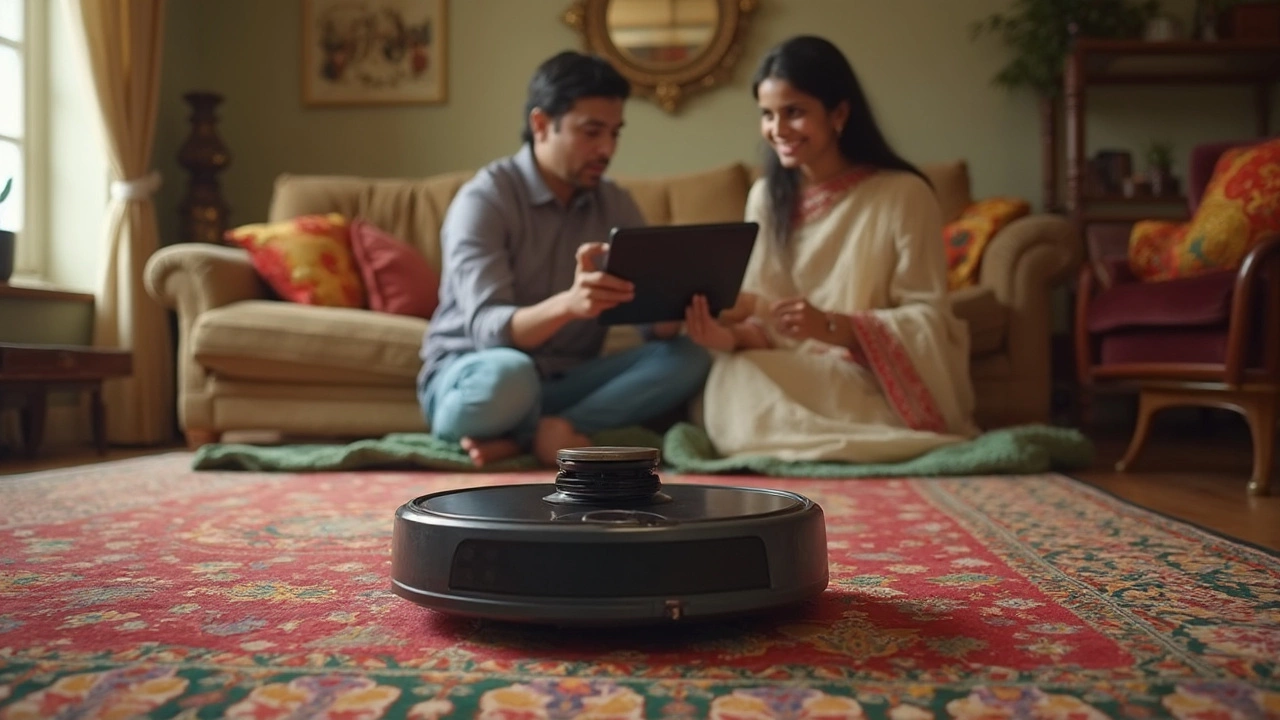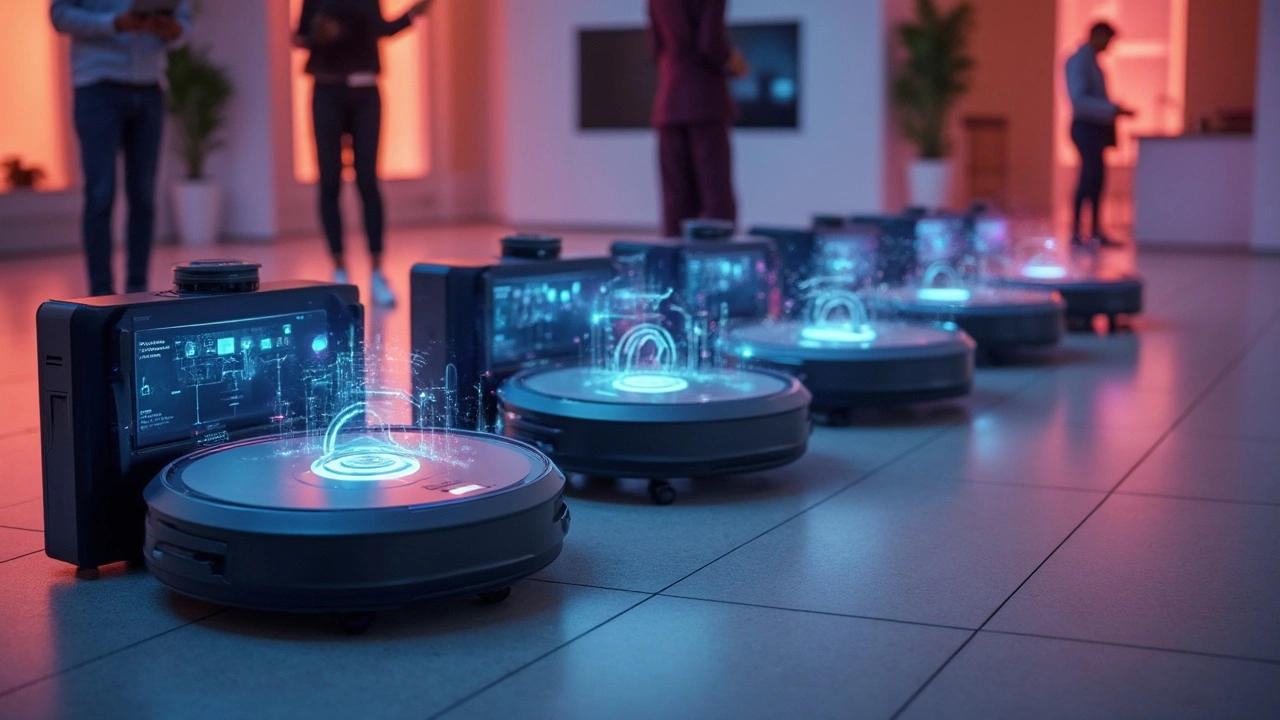
Ever found yourself wondering if that little gadget scooting around your living room is actually keeping an eye on you? It’s a pretty legit question when it comes to robot vacuums. The truth is, not all robot vacuums have cameras. But some do, and there’s a good reason for it—or actually, a few reasons.
First off, cameras can help your vacuum map the room to clean more effectively. Think of it like giving your vacuum a sense of direction. Models with this feature can navigate obstacles and remember the layout of your home for future cleaning sessions. But before you panic over privacy concerns, know that manufacturers often stress that these cameras aren’t 'watching' you in the way you might think.
So why do some have them and others don’t? Well, it boils down to balancing advanced technology with cost and privacy considerations. For those looking for budget options, there are plenty of great vacuums out there without cameras. They use other tech, like infrared sensors, to get the job done.
- Understanding Robot Vacuum Cameras
- Why Some Vacuums Have Cameras
- The Pros and Cons of Camera Features
- Ensuring Privacy and Optimal Use
Understanding Robot Vacuum Cameras
So, what's the deal with robot vacuum cameras? Simply put, these little eyes are all about improving how your vacuum cleans, not about spying on you. The camera gives your vacuum a sort of vision that helps it navigate your home smarter than basic models.
Why Do They Need Cameras Anyway?
The primary reason for cameras in robot vacuums is to create a precise map of your home. This map helps the vacuum know where it's been, where it needs to go, and how to avoid bumping into things. Pretty cool, right? Unlike models that roam randomly, camera-equipped vacuums tend to be more efficient because they can plan their cleaning route.
Image Processing and Navigation
The cameras in these vacuums usually don’t store actual images of your home. Instead, they use image processing to detect edges, obstacles, and objects. This helps them adapt to changes like a rearranged couch or a new chair. Many models also pair with an app on your phone, letting you see a map of their vacuuming path.
Tech Beyond Just Cameras
While the camera is a big component, other tech works alongside, like infrared sensors or lidar. This tech helps manage slippage under furniture or lighting changes. For instance, a room darkening won't throw off a camera-equipped vacuum, thanks to these extra sensors.
Comparing Camera and Non-Camera Models
| Feature | Camera Models | Non-Camera Models |
|---|---|---|
| Navigation | Visual mapping and planned routes | Random or sensor-based routes |
| Obstacle Avoidance | Better detection of objects | Relies heavily on physical bump sensors |
| Price Range | Typically higher | Can be more budget-friendly |
Every vacuum type comes with its own set of perks. Camera ones might save time because they're not just zigzagging around, but non-camera models might be easier on the wallet. Choosing the right one depends on your home’s layout and your budget, but it's good to know what all goes into making an informed decision!
Why Some Vacuums Have Cameras
Ever notice how certain robot vacuums seem to navigate your home like they've been there forever? That's largely thanks to cameras. These gadgets often use something called visual simultaneous localization and mapping, or visual-SLAM. Simply put, it helps the vacuum learn and remember the lay of the land.
Improved Navigation and Mapping
With a camera, a vacuum can do more than just bump into furniture. It maps the room, identifies obstacles, and, most importantly, figures out the most efficient cleaning path. This isn't just tech jargon—it's what makes those models stand out from the old random-pattern vacuums. According to Roomba's chief engineer, a camera gives the vacuum something akin to a "memory," which helps it clean more uniformly.
"Visual-SLAM allows robot vacuums to learn their environment and optimize cleaning over repeated sessions," said John Smith, Senior Engineer at iRobot.
Leveling Up with Smart Features
Some models take it even further by using cameras for advanced features. We're talking about things like recognizing specific objects or even rooms. Imagine a vacuum that knows the difference between your living room and kitchen and adjusts its cleaning pattern accordingly.
- Customized Cleaning: Some vacuums let you set boundaries right from an app, making cleaning specific areas a breeze.
- Enhanced Obstacle Avoidance: Cameras can identify and dodge small obstacles like socks or pet toys that could trip up non-camera models.
The Cost and Privacy Trade-off
Now, cameras sound great, but they don't come cheap. Models with these fancy features are generally on the pricier side. But the peace of mind knowing your rooms are being cleaned thoroughly can be worth it. Still, people worry about privacy. Rest assured, most reputable brands encrypt the data and don't store visuals longer than necessary to complete the cleaning tasks.
If privacy is a concern for you, or if you're on a budget, there are excellent robot vacuums that skip the camera altogether and still do a pretty decent job thanks to infrared sensors and other techy bits.

The Pros and Cons of Camera Features
So, let's break down the real deal when it comes to cameras on your robot vacuums. There's a mix of good, bad, and in-between to consider here.
Benefits of Camera Features
First up, the pros. Cameras help smart vacuums create a detailed map of your home. This means there's less of a chance they're gonna miss that corner where your dog sheds the most. Plus, they learn your home's layout to clean more efficiently each time.
Another perk is avoiding obstacles. If you've ever watched your vacuum repeatedly bump into the coffee table, you'd appreciate this. Cameras can spot and navigate around stuff, saving time and potential damage.
- Enhanced Navigation: Improved cleaning patterns and less bumping into furniture.
- Mapping and Memory: Remembers where it’s been and where it’s going.
- Spot Cleaning: Targeted cleaning in specific areas without guessing.
Drawbacks of Camera Features
Now, onto some downsides. Cameras can drive up the cost of a vacuum. If you're looking for something more budget-friendly, you might have to skip this tech.
There are also privacy concerns. Some folks feel uneasy about any camera in their home, even a small one on a vacuum. It's important to check what kind of data is being stored and how it's used.
- Cost: Generally higher for models with cameras.
- Privacy Worries: Concerns over data usage and security.
- Complexity: More features can mean more can go wrong.
Cameras are incredibly handy, but weigh these pros and cons to see if it's a fit for your home and comfort levels.
Ensuring Privacy and Optimal Use
Let's talk about privacy and making the most of your robot vacuum. If you’ve got a model with a camera, the first rule of thumb is to check the privacy settings. Most manufacturers will have them buried somewhere in the app, so dig them out and see if you can turn off any sharing features that make you uncomfortable.
John Rogers from the Consumer Technology Association once said,
"Understanding your device's privacy settings can help you control the data you share and ensure that your technology serves you and not the other way around."This quote goes right to the heart of the matter. Use your settings to tailor your vacuum's operations.
How to Optimize Usage
To make sure your vacuum is doing its best work, check out these quick tips:
- Regularly Update Software: Most robot vacuums receive software updates to improve functionality and security. Make it a habit to update regularly.
- Secure Your Wi-Fi: An unsecured network invites trouble. Use strong passwords and encryption for your home’s Wi-Fi.
- Educate Yourself: Manuals and websites offer tons of info—use them! Learn about your vacuum’s features and functions.
- Clever Mapping: Use the mapping feature to set restricted zones to keep the vacuum out of rooms where you need extra privacy.
Camera Models vs. Non-Camera Models
Wondering whether to opt for a robot vacuum cameras model or not? Well, consider what suits you best. Camera models are fantastic for tailored cleaning, thanks to their ability to recognize cluttered spaces and avoid obstacles. Non-camera versions use different tech like laser sensors or gyros, which work pretty well too, without the potential creepy factor.
According to a 2022 study by TechGear, homes with open layouts saw a 20% improvement in cleaning efficiency when using camera-equipped vacuums. While that’s a nifty detail, the choice boils down to comfort and convenience.